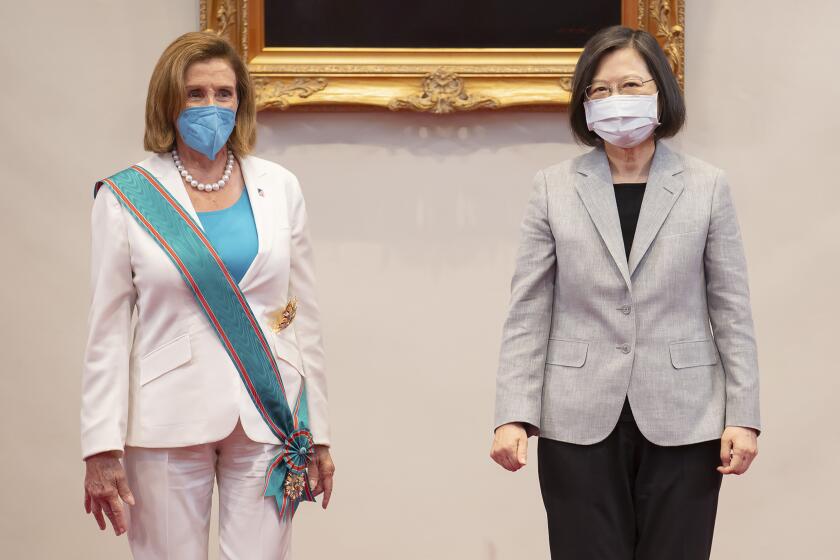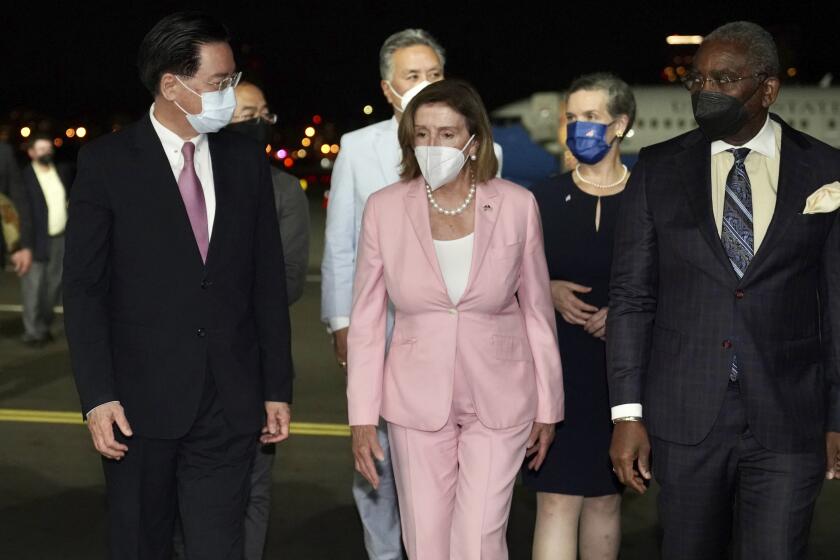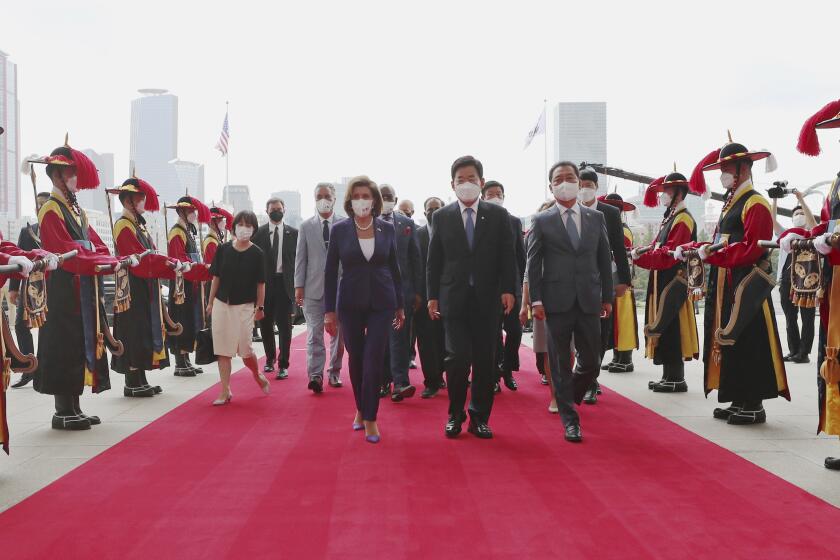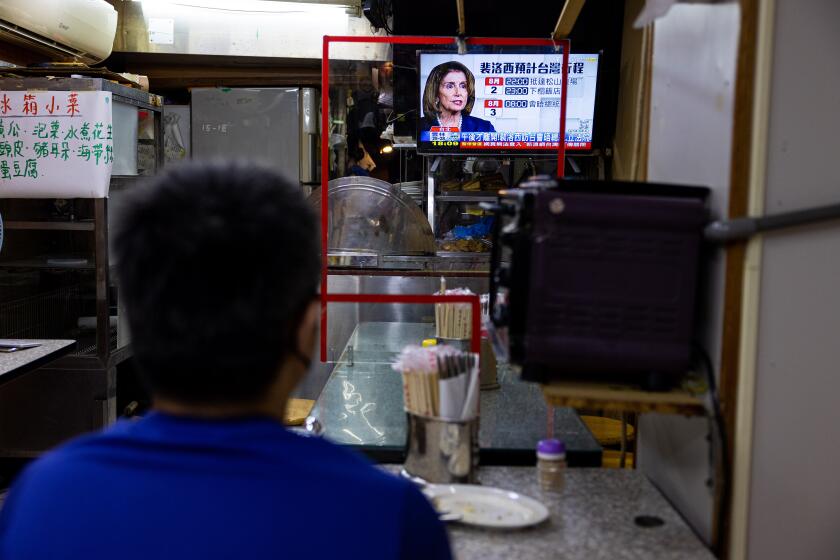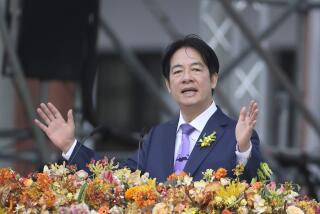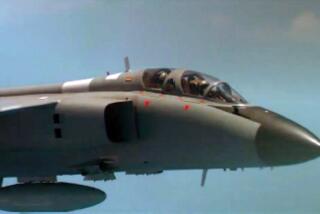China conducts ‘precision missile strikes’ near Taiwan after Pelosi visit
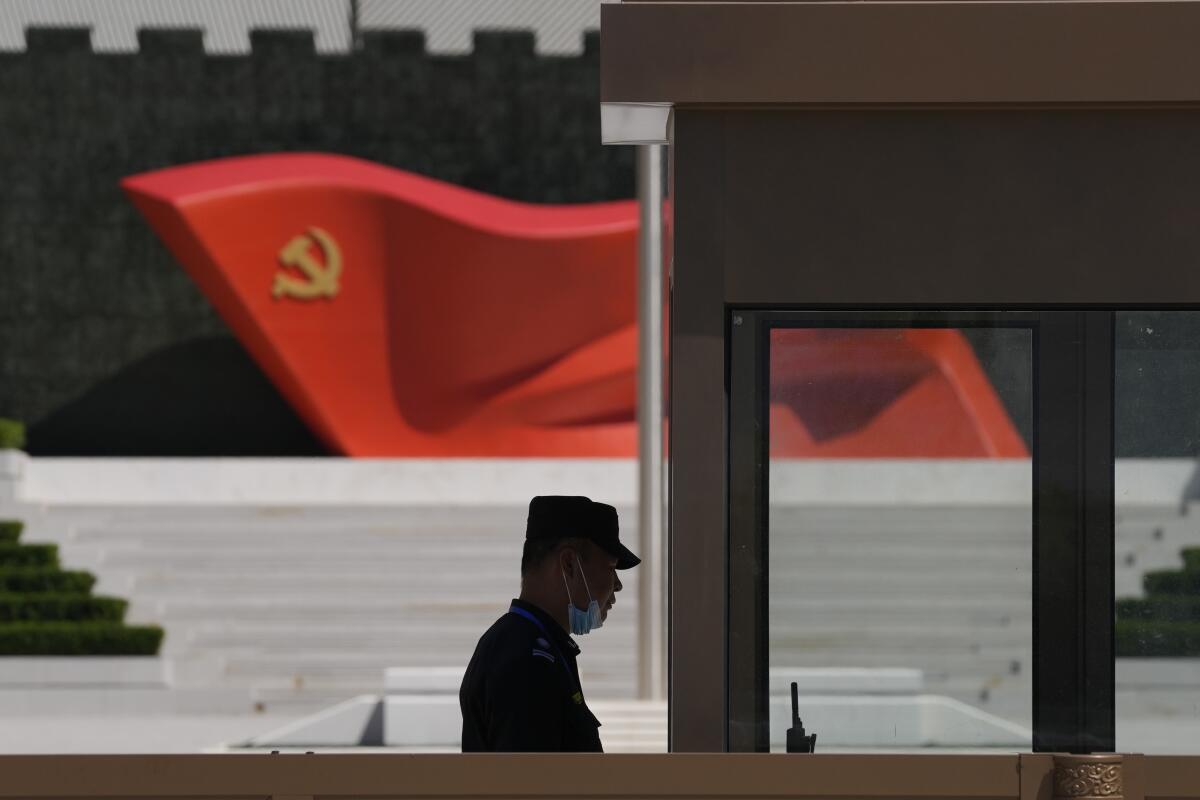
KEELUNG, Taiwan — China conducted “precision missile strikes” Thursday in waters off Taiwan’s coasts as part of military exercises that have raised tensions in the region to their highest level in decades following a visit by U.S. House Speaker Nancy Pelosi.
China earlier announced that military exercises by its navy, air force and other departments were underway in six zones surrounding Taiwan, which Beijing claims as its territory, to be annexed by force if necessary.
Five missiles landed inside Japan’s Exclusive Economic Zone off its coast, Japanese Defense Minister Nobuo Kishi said.
He said Tokyo protested the missile landings to Beijing as “serious threats to Japan’s national security and the safety of the Japanese people.” The missiles landed off Hateruma, an outer island far from Japan’s main islands, he said.
The drills were prompted by a visit to Taiwan this week by Pelosi (D-San Francisco) and are intended to advertise China’s threat to attack the self-governing island republic. Along with its moves to isolate Taiwan diplomatically, China has long threatened military retaliation over moves by the island to solidify its de facto independence with the support of key allies, including the U.S.
China fired long-range explosive projectiles, the Eastern Theater Command of the People’s Liberation Army, the ruling Communist Party’s military wing, said in a statement. It also said it carried out conventional missile launches in three areas in the eastern waters off Taiwan. An accompanying graphic on state broadcaster CCTV showed that those occurred in the north, east and south.
“All missiles hit the target accurately,” the Eastern Theater said in its announcement. No further details were given.
China’s furious response could drive more Taiwanese toward independence and push neighboring Asian nations to strengthen their defense strategies.
Taiwan’s Defense Ministry said it tracked the firing of Chinese Dongfeng missiles beginning about 1:56 p.m. local time Thursday. It said in a statement that it had used various early-warning surveillance systems to track the missile launches. It later said it counted 11 Dongfeng missiles in the waters in the north, east and south.
The ministry also said it tracked long-distance rockets and ammunition firing in outlying islands in Matsu, Wuqiu and Dongyin.
Taiwanese President Tsai Ing-wen criticized the drills in a video address, saying China had “destroyed the status quo and violated our sovereignty” with its “irresponsible actions.” She urged China to be “reasonable and restrained.”
“We are calm and not impulsive, we are reasonable and not provocative,” she said. “But we will also be firm and not back down.”
For Pelosi, the Taiwan visit is a legacy-building trip that may serve as a capstone to her long record as a critic of China.
Tsai said Taiwan was in communication with its allies to ensure that things do not escalate further.
The Defense Ministry said its forces were on alert and monitoring the situation, while seeking to avoid escalating tensions. Civil defense drills have also been held, and notices were placed on designated air raid shelters.
China’s “irrational behavior” intends to alter the status quo and disrupt regional peace and stability, the ministry said.
“The three service branches will combine efforts with all the people to jointly safeguard national security and territorial integrity” while adapting to the situation as it develops, the statement said.
After infuriating China with her stop in Taiwan, House Speaker Nancy Pelosi has met with South Korean political leaders on her tour of Asia.
China’s official Xinhua News Agency reported that the exercises were joint operations focused on “blockade, sea target assault, strike on ground targets and airspace control.”
Ma Chen-kun, a professor at Taiwan’s National Defense University, said the drills were aimed at showing off the Chinese military’s ability to deploy precision weapons to cut off Taiwan’s links with the outside and facilitate the landing of troops.
The announced drills are “more complete, and if the People’s Liberation Army actually invades Taiwan in an all-out invasion, the concrete actions it will take, it’s all in this particular exercise,” Ma said.
“The main thing is they will cut off Taiwan’s links to the outside world from their sea. They would suppress the coastal defense firepower,” he said.
Breaking News
Get breaking news, investigations, analysis and more signature journalism from the Los Angeles Times in your inbox.
You may occasionally receive promotional content from the Los Angeles Times.
Meanwhile, the mood in Taiwan was calm.
In Keelung, a city on the northern coast close to two of the announced drill areas, swimmers took their morning laps in a natural pool built in the ocean.
Lu Chuan-hsiong, 63, who was enjoying his morning swim, said he wasn’t worried.
“Because Taiwanese and Chinese, we’re all one family. There’s a lot of mainlanders here, too,” he said.
“Everyone should want money, not bullets,” he quipped, saying the economy wasn’t doing so well.
A stronger army is needed to deter a wider conflict that could entangle the U.S. at a time when calls are growing in Washington to defend the island.
Those who have to work on the ocean were more concerned. Fishermen are likely to be the most affected by the drills, which cover six areas surrounding Taiwan, part of which come into the island’s territorial waters.
Most fishermen will continue to try to fish, as it is the season for squid.
“It’s very close. This will definitely impact us, but if they want to do this, what can we do? We can just avoid that area,” said Chou Ting-tai, who owns a fishing vessel.
While the U.S. has not said it would intervene, it has bases and forward-deployed assets in the area, including aircraft carrier battle groups. On Thursday, the U.S. Navy said the aircraft carrier Ronald Reagan was operating in the Philippine Sea, east of Taiwan, as part of “normal scheduled operations.”
Even if Pelosi had skipped Taipei on her tour of Asia, America’s gradually shifting policy on Taiwan has increased China’s tensions with the U.S.
U.S. law requires the government to treat threats to Taiwan, including blockades, as matters of “grave concern.”
The Chinese military drills are due to run from Thursday to Sunday and include missile strikes on targets in the seas north and south of the island, in an echo of the last major Chinese military drills aimed at intimidating Taiwan’s leaders and voters in 1995 and 1996.
On the diplomatic front, China canceled a foreign ministers’ meeting with Japan to protest a statement from the Group of 7 industrialized nations that there was no justification for the exercises. Both ministers are attending a meeting of the Assn. of Southeast Asian Nations in Cambodia.
“Japan, together with other members of the G-7 and the EU, made an irresponsible statement accusing China and confounding right and wrong,” Chinese Foreign Ministry spokeswoman Hua Chunying said in Beijing.
While China has given no word on numbers of troops and military assets involved, the exercises appear to be the largest held near Taiwan in geographical terms.
The exercises involved troops from the navy, air force, rocket force, strategic support force and logistic support force, Xinhua reported.
More to Read
Sign up for Essential California
The most important California stories and recommendations in your inbox every morning.
You may occasionally receive promotional content from the Los Angeles Times.
